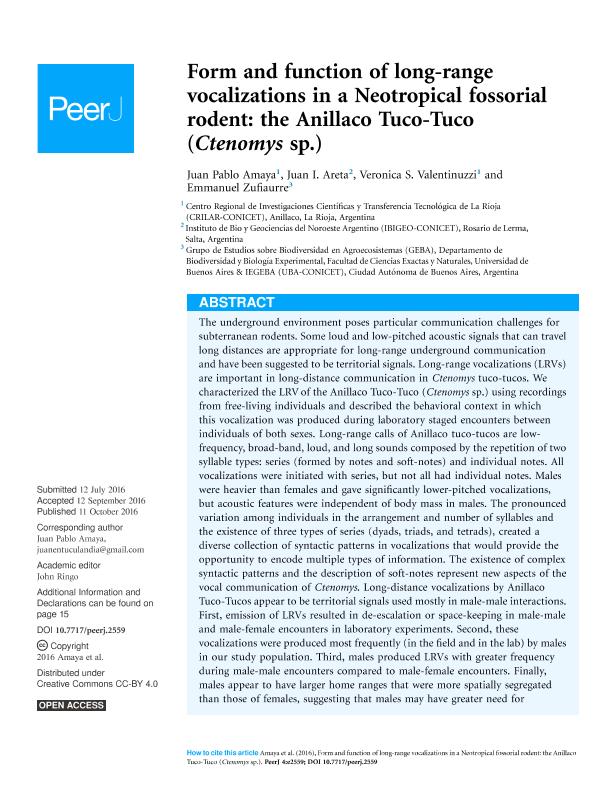Artículo
Form and function of long-range vocalizations in a Neotropical fossorial rodent: The Anillaco Tuco-Tuco (Ctenomys sp.)
Fecha de publicación:
11/10/2016
Editorial:
PeerJ Inc.
Revista:
PeerJ
ISSN:
2167-8359
Idioma:
Inglés
Tipo de recurso:
Artículo publicado
Clasificación temática:
Resumen
The underground environment poses particular communication challenges for subterranean rodents. Some loud and low-pitched acoustic signals that can travel long distances are appropriate for long-range underground communication and have been suggested to be territorial signals. Long-range vocalizations (LRVs) are important in long-distance communication in Ctenomys tuco-tucos. We characterized the LRV of the Anillaco Tuco-Tuco (Ctenomys sp.) using recordings from free-living individuals and described the behavioral context in which this vocalization was produced during laboratory staged encounters between individuals of both sexes. Long-range calls of Anillaco tuco-tucos are lowfrequency, broad-band, loud, and long sounds composed by the repetition of two syllable types: series (formed by notes and soft-notes) and individual notes. All vocalizations were initiated with series, but not all had individual notes. Males were heavier than females and gave significantly lower-pitched vocalizations, but acoustic features were independent of body mass in males. The pronounced variation among individuals in the arrangement and number of syllables and the existence of three types of series (dyads, triads, and tetrads), created a diverse collection of syntactic patterns in vocalizations that would provide the opportunity to encode multiple types of information. The existence of complex syntactic patterns and the description of soft-notes represent new aspects of the vocal communication of Ctenomys. Long-distance vocalizations by Anillaco Tuco-Tucos appear to be territorial signals used mostly in male-male interactions. First, emission of LRVs resulted in de-escalation or space-keeping in male-male and male-female encounters in laboratory experiments. Second, these vocalizations were produced most frequently (in the field and in the lab) by males in our study population. Third, males produced LRVs with greater frequency during male-male encounters compared to male-female encounters. Finally, males appear to have larger home ranges that were more spatially segregated than those of females, suggesting that males may have greater need for long-distance signals that advertise their presence. Due to their apparent rarity, the function and acoustic features of LRV in female tuco-tucos remain inadequately known.
Palabras clave:
Ctenomyidae
,
Fossorial Rodents
,
Underground Bioacustics
,
Vocal Communication
Archivos asociados
Licencia
Identificadores
Colecciones
Articulos(CRILAR)
Articulos de CENTRO REGIONAL DE INV. CIENTIFICAS Y TRANSFERENCIA TECNOLOGICA DE ANILLACO
Articulos de CENTRO REGIONAL DE INV. CIENTIFICAS Y TRANSFERENCIA TECNOLOGICA DE ANILLACO
Articulos(IBIGEO)
Articulos de INST.DE BIO Y GEOCIENCIAS DEL NOA
Articulos de INST.DE BIO Y GEOCIENCIAS DEL NOA
Articulos(IEGEBA)
Articulos de INSTITUTO DE ECOLOGIA, GENETICA Y EVOLUCION DE BS. AS
Articulos de INSTITUTO DE ECOLOGIA, GENETICA Y EVOLUCION DE BS. AS
Citación
Amaya, Juan Pablo; Areta, Juan Ignacio; Valentinuzzi, Verónica Sandra; Zufiaurre, Emmanuel; Form and function of long-range vocalizations in a Neotropical fossorial rodent: The Anillaco Tuco-Tuco (Ctenomys sp.); PeerJ Inc.; PeerJ; 10; 11-10-2016
Compartir
Altmétricas




